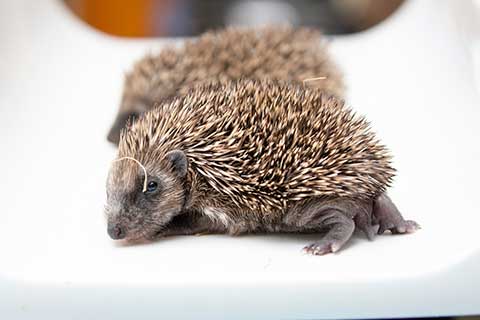Hoglets can make a squeaking sound to attract their mum's attention
Hedgehogs in the garden
Hedgehogs are regular garden visitors, and an important part of the ecosystem! The right gardens can be a hedgehog haven; a hotspot for nutritious foods like insects and worms, and safe shelters to see hedgehogs through hibernation.
On this page, we’ll show you how to spot the signs of a hedgehog in the garden, how to attract them, and how you can help them thrive.

Jump to:
Spot the signs of hedgehogs in your garden
Despite their small size and quiet nature, you can spot signs that a hedgehog has visited your garden if you know what to look for. The two most obvious ones are tracks and poo.
Hedgehog tracks
Hedgehog tracks can be tricky to spot, as while they have five toes on each foot, often only four will be seen in their footprints. Their front feet leave tracks that look like tiny handprints, whilst their back feet are longer and more narrow.
You can use kits like footprint tunnels to capture the tracks more visibly.
Hedgehog poo
Hedgehog poos are about 5 cm in length, cylindrical and generally dark in colour. They often contain bits of insects and worms. See what hedgehog poo looks like (but maybe after you’ve finished eating).
If the poo looks green, slimy, sticky or mucus-covered, this could be a sign that the hedgehog is sick. Learn how to help a sick or injured hedgehog.
Did you know?
As many as 10 different hedgehogs may visit a garden over several nights.
This could mean 'your hedgehog' is actually a number of different hedgehogs visiting at different times!
Hedgehog-friendly gardens
Hedgehogs are regular garden explorers because of the varied food sources and nesting spots a garden can provide. Especially for a hibernating hedgehog.
Hedgehogs are also a gardener's friend, as they eat beetles, caterpillars, worms and other invertebrates that might harm plant life.
Here’s how to attract hedgehogs to your garden, and keep them happy throughout the year:
Make a shelter
You can make natural shelters out of piles of logs, leaves or compost (always check for hedgehogs first before moving a pile or lighting a bonfire). You could also buy a purpose-built hedgehog house or find out how to build your own. Hedgehogs like patches of undisturbed brambles too, so try to leave some ‘wild areas’ for them to enjoy.
Provide a hedgehog highway
Hedgehogs can travel around 3km (almost two miles) every night. Make sure they have a clear route between gardens by cutting 13 x 13cm (5 x 5in) holes at the base of fences, removing bricks from walls or digging tunnels under the garden boundary – just check with your neighbours first! You can buy a hedgehog highway tool from our shop.
Leave out food and water
Leaving food and fresh water out in the garden each night will encourage visiting hedgehogs to return regularly. Try tinned meaty cat or dog food and crushed cat or dog biscuits. Place the food and water in shallow bowls so they can access them easily. Refresh daily, disposing of food if it’s not been eaten.
Never give hedgehogs milk, as they’re lactose intolerant and it can cause diarrhoea. Or bread, as it provides no nutritional benefit for them.
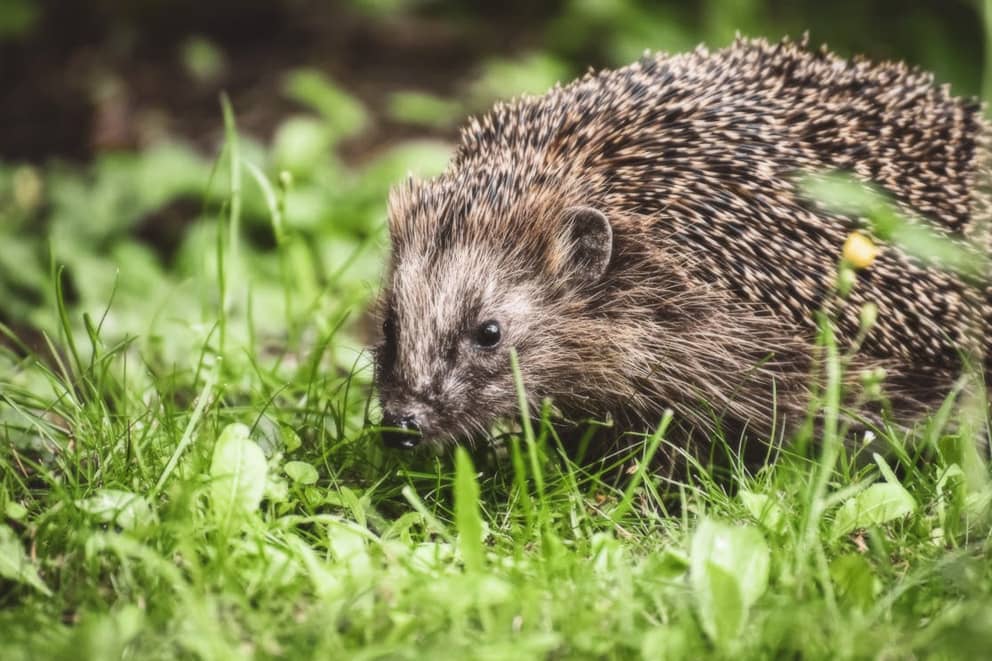
Everyone can help make gardens safer – check for wildlife before you strim or mow.
As well as adding things like shelters, highways and foods, there are things you can do to existing elements of your garden to ensure they’re hedgehog-safe:
Bonfires
Always thoroughly disturb bonfires immediately before you light them, as there could be hedgehogs nesting or hiding inside. Moving the whole bonfire by hand before setting it alight is the best way of ensuring that hedgehogs and other wildlife aren't sleeping in there. Or learn how to build a hedgehog-friendly bonfire.
Compost heaps
Check compost heaps before forking or turning them over, to make sure there are no hedgehogs or other animals nesting in them.
Drains
Drains and similar open holes frequently trap unwary hedgehogs, who can starve if they’re not rescued. Keep all drain covers in good condition and cover any open holes to stop hedgehogs from falling in.
Litter
Litter is a real and recurring hazard for many small animals. Hedgehogs frequently get their heads stuck in tins, plastic bags, plastic rings from multipacks of drink cans, yoghurt pots and elastic bands. Make sure you dispose of your rubbish safely – cutting loops, rinsing out food containers and flattening tins and cans if you can – and check there’s no litter in your garden.
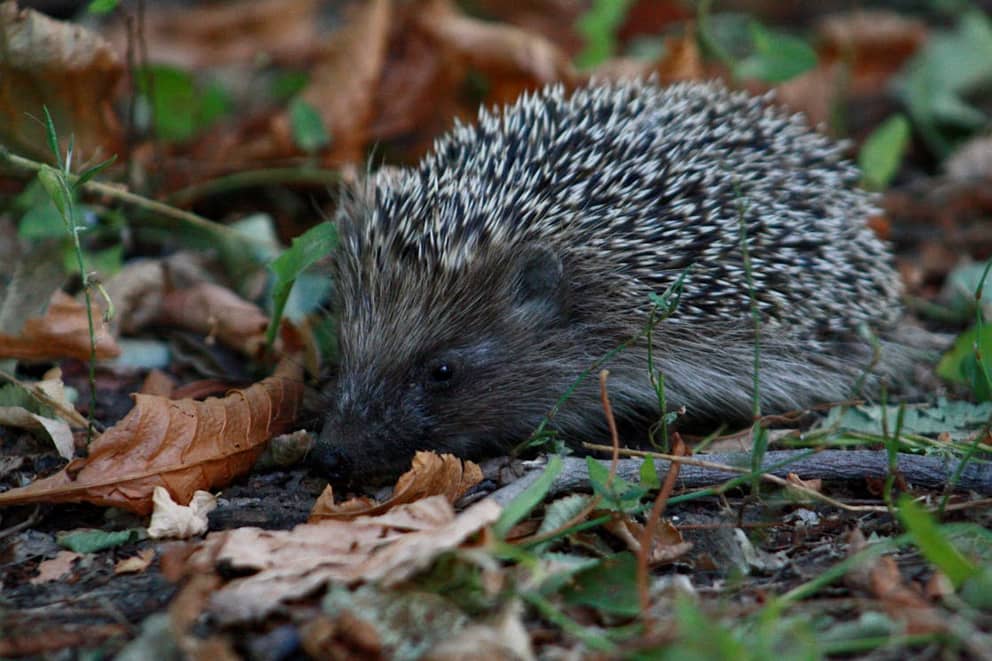
Garden ponds
Garden ponds can be dangerous to hedgehogs and other small animals as there’s a chance they may fall in. Although hedgehogs are good swimmers, they may struggle to get out. To make your pond hedgehog-friendly:
- Provide an easy escape route around the pond for the hedgehog to climb out, ensuring there’s a gentle slope on at least one side, or build steps out of bricks.
- Cover the pond with wire mesh to prevent them from falling in.
If you have a swimming pool, ideally it should have shallow steps (so any hedgehogs that have fallen in can easily climb out) and a tight-fitting insulating cover on it overnight (to stop hedgehogs from falling in).
Remember to check your pond or pool every day.
Netting
Pack away or roll up netting and store it at least 30cm (1ft) above the ground when not in use. Keep fruit nets taut to reduce the risk of animals getting tangled up in them, or replace with solid mesh if possible. Make sure all barbed wire is also kept off the ground.
Slug pellets and pesticides
The chemicals used in these can poison hedgehogs. Try using a natural, non-lethal alternative instead, such as sprinkling crushed eggshells or coffee grounds around the plants you’d like to protect. It’s illegal to use slug pellets containing metaldehyde outdoors in Great Britain.
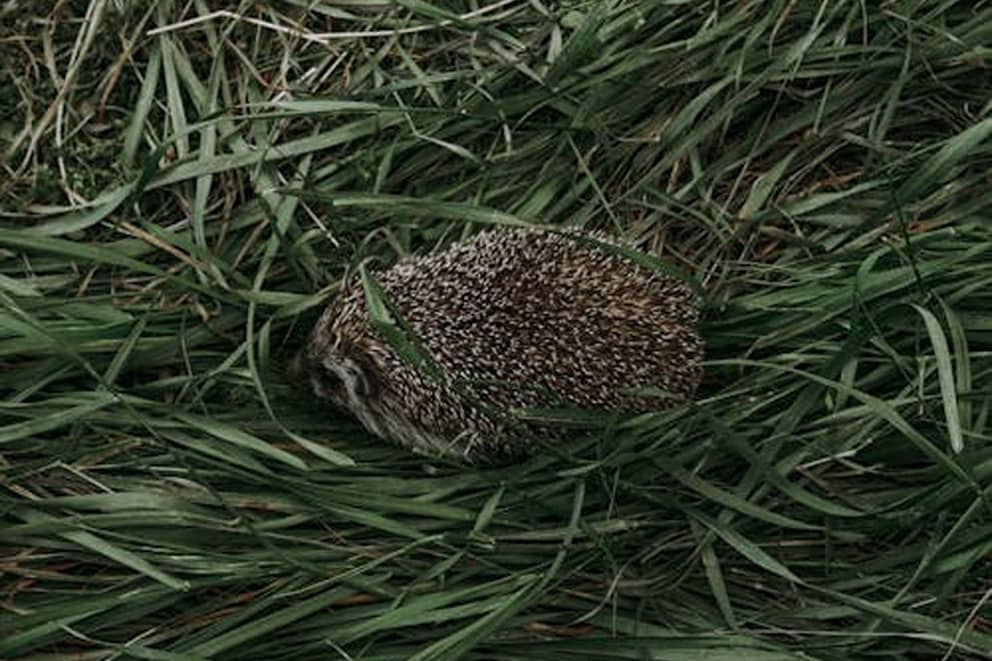
Sheds
Don't close your shed doors if you usually keep them open, as there may be hedgehogs nesting inside. Keep any dangerous chemicals or tools well off the ground. If you need to dismantle your shed, first check carefully underneath the floor for nesting or hibernating hedgehogs.
Strimmers and mowers
Always check any areas you want to cut or strim before you start. Use these as little as possible under hedges and in other areas of undergrowth, as hedgehogs and other animals are likely to be resting there during the day. Alternatively, let your grass grow! It’s great for wildlife and insects.
Found a sick or injured hedgehog?
Strimmer accidents, unchecked bonfires, open ponds or netting left lying around are all risks to a hedgehog’s safety. If you find a sick or injured hedgehog in your garden, learn how you can help.
Pets and hedgehogs
If there’s a hedgehog in your garden and you have a dog, cat or other pet, there are a few things to bear in mind:
Dogs and hedgehogs
Unfortunately, dogs can and commonly do hurt or even kill hedgehogs. While adult hedgehogs are often able to protect themselves with their spikes, sick or young hedgehogs are vulnerable to attack. You can protect the hedgehogs in your garden by:
- Keeping your dog away from where the hedgehog is.
- Warning the hedgehog before you let your dog out (by turning on the outside light, for example).
- Supervising your dog or putting your dog’s lead on, especially if you know it's prone to attack, particularly at dusk or night when hedgehogs are more likely to be around.
- Taking note of the hedgehog's routine – they tend to appear at certain times in certain places. Try to let your dog out when the hedgehog isn’t around.
Cats and hedgehogs
Cats aren’t typically a threat to hedgehogs. Most of the time they simply keep to themselves, or watch the hedgehog curiously.
The biggest ‘problem’ cats pose to hedgehogs is potentially pinching any of the meaty cat food you’ve left out for the hedgehog. To combat this, you can create a hedgehog feeding station with a tunnel entrance for the hedgehog, which will also protect the food from the weather.
Will hedgehogs give my pet fleas?
Hedgehogs have built up quite the reputation for having fleas – but they can’t pass these fleas onto dogs or cats. Hedgehog fleas are specific to the hedgehog (called Archaeopsylla erinacei), which means they won’t survive for long on any other species.
Test your hog knowledge
test your knowledge
Your answer is incorrect.
What to feed hedgehogs
Hedgehogs mostly eat caterpillars, beetles and earthworms, but one of the reasons hedgehogs are in decline is because of the lack of natural food available to them (often because of pesticides and slug pellets reducing food sources).
You can help to sustain them, especially through hibernation, by putting out food for these garden wanderers whenever they stop by. Here’s what to feed hedgehogs in the garden to help them thrive:
- Tinned cat or dog food: Preferably meat-based.
- Crushed cat or dog biscuits: And try not to let your cat or dog pinch them!
- Fresh water in a shallow dish: This helps them to stay hydrated, especially in the warmer weather.
Never feed hedgehogs milk or bread – they're lactose intolerant, so milk and bread can disrupt their digestive system and cause diarrhoea.
Check the hedgehog food and water bowls each day to top them up with fresh water and food, and remove any food that hasn't been eaten.
Remember to always clean the dishes daily (do this outside, not in the kitchen), using hot, soapy water and to rinse well. This will help to reduce the risks of spreading disease between different hedgehogs that might eat from the same dish.
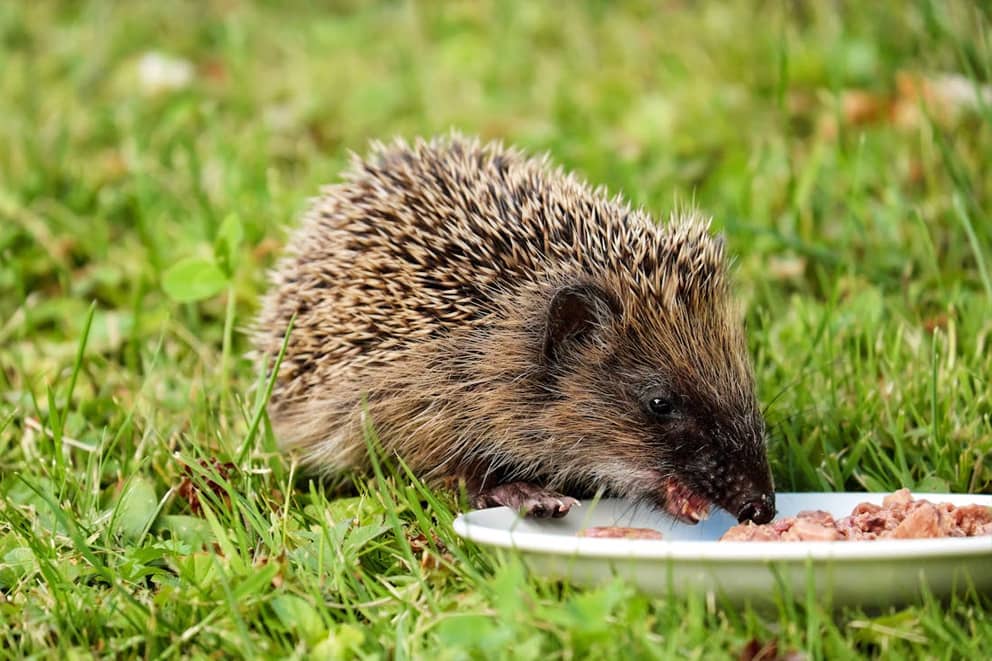
Did you know?
Hedgehogs may occasionally prey on frogs, toads, small rodents, baby birds, slugs and snails, bird eggs and even fruit.
They’ve not got a picky palette!



